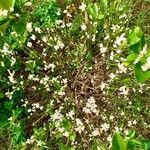An evergreen shrub up to 4 m high. It spreads to 2 m across. The stem is slender and branching. It has a rounded crown. It has spiny branches and shiny oval leaves with pointed tips. The leaves are leathery. Flowers are white with 5 petals. They occur singly and have a perfume. Fruit are very small and about 2.5 cm across. They are divided into only 3-6 sections. There are 2-5 seeds.
A shrub which keeps its leaves all year round. It grows about 2-4 m tall. It is spiny. The leaves are a narrow oval shape. They taper sharply at both ends. The leaf stalks have wings. The flowers are white, short and broad. The fruit are a flattened round shape. They are 1-2 cm across. They have 3-4 segments. The fruit become a bright orange when ripe.
A shrub or small tree. It often lacks thorns. The leaves are thick and rigid and often folded lengthwise. They have many dark green oil glands. The leaves are small. The leaf stalks have narrow wings. The fruit are oval or almost round. The fruit is small, orange and sweet. They are 3-4 cm across. The skin is edible. The fruit have about 7 segments.
A small evergreen tree. It is thorny. It grows to about 4 m high. The leaves are simple and entire. They are up to 7 cm long. They have blunt tips. They are leathery. The flowers are white. The fruit are 3 cm across. They are smooth and shiny. They are divided into 4-7 compartments. They are yellow. The skin is thin and waxy and is spicy.

